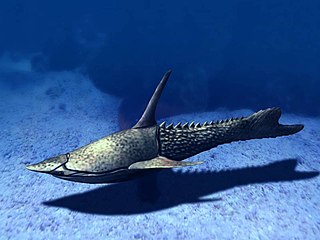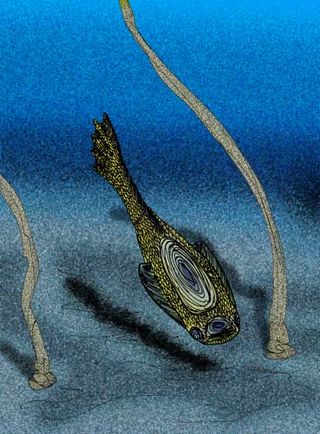Related Research Articles

Heterostraci is an extinct subclass of pteraspidomorph jawless vertebrate that lived primarily in marine and estuary environments. Heterostraci existed from the mid-Ordovician to the conclusion of the Devonian.

Protaspididae is an extinct family of pteraspidid heterostracan agnathans. Fossils of the various genera are found in early Devonian-aged marine strata. Protaspidids were once thought to represent a transitional form between the Pteraspididae and the Psammosteida, bearing the broad head shield shape of the latter, due to a more benthic (bottom-dwelling) existence, but recent phylogenical comparisons demonstrate that the protaspidids are actually highly derived pteraspidids, and that the anchipteraspidids, the most primitive of pteraspidids, are the sister-group of the Psammosteids.

Macrodontophion is the name given to a dubious genus of lophotrochozoan from the Early Devonian Dniester Series of Podolia, Ukraine. It was described by Adalbert Zborzewsky in 1834, but was never given a species epithet, and is considered a nomen dubium, because it is based only on fragments, such as the holotype, a shell of 25 millimetres (0.98 in).

Pteraspis is an extinct genus of pteraspidid heterostracan agnathan vertebrate that lived from the Lochkovian to Eifelian epochs of the Devonian period in what is now Brazil, Britain, Ukraine and Belgium.

Errivaspis is an extinct genus of pteraspid heterostracan agnathan vertebrate known from fossils at the Wayne Hereford Quarry, of Early Devonian England, and of Podolia, Early Devonian Ukraine. It was originally described by Dr. Errol Ivor White as one of five form-variants of Pteraspis rostrata, i.e., "Pteraspis rostrata var. waynesis. In 1984, Alain Blieck moved var. waynesis into its own genus, Errivaspis, which he named after Dr. White. Other later researchers would then mistakenly assume that Blieck synonymized the entire genus of Pteraspis into Errivaspis.

Ctenaspis is an extinct genus of heterostracan cyathaspid agnathans from the early Devonian of Canada, Norway and Russia 416.0 to 412.3 million years ago. Species of Ctenaspis are typically 10 to 18 cm long with the max length being 40 cm long. The genus contains only one known species, namely Ctenaspis kaieri.

Traquairaspis is a genus of extinct heterostracan agnathan fish known from the Silurian and Early Devonian periods. It is predominantly known from Late Silurian fluvial deposits from Wales and England: some species were also found in shallow water marine environment in Canada and North America.
Semipodolaspis is an extinct genus of jawless fish.
Djurinaspis is an extinct genus of jawless fish which existed during the early Devonian period. It was originally described by Novitskaya in 1983. A new species, D. secunda, from Ukraine was described by Victor Voichyshyn in 2011.

Podolaspis is an extinct genus of pteraspidid heterostracan agnathan which existed during the early Devonian period. It was originally described by Zych in 1931, and contains the species P. lerichei, and P. danieli.
Lechriaspis is an extinct genus of poraspid heterostracan agnathan known from the Early Devonian of northern Utah, western United States.

Protopteraspis is an extinct genus of pteraspidid heterostracan agnathan with fossils known from Lower Devonian marine strata in Western Europe. The animal's somewhat flat build has led some to believe that it was a bottom dweller, living in freshwater areas. It has been described as "somewhat unspecialized". Its snout was round and narrow, shorter than that of its immediate relatives. Protopteraspis also did not possess the cornua (horns) found on the headshields of other pterapsids; rather, it had "small points" behind the gill opening. It did possess a "medium-sized" dorsal spine. Plates covering the headshield had ridges of dentine. It is theorized that the headshield formed in youth and that it grew via growth of the plates, which fused in adulthood. The scales of the animal were "small and diamond shaped".

Cardipeltis is an extinct genus of heterostracan agnathan from marine strata of early Devonian of Utah, and Wyoming. Species of Cardipeltis superficially resemble those of cyathaspids in having a flattened body and indistinct head covered by a large, broad, guitar pick or heart-shaped dorsal shield, and a long, scaly tail. Unlike cyathaspids, which all have a single ventral plate, however, the ventral shield of Cardipeltis is a mosaic composed of large scales.

Pteraspidiformes is an extinct order of heterostracan agnathan vertebrates known from extensive fossil remains primarily from Early Devonian strata of Europe and North America, and from Upper Silurian Canada.

Cyathaspidiformes is an extinct order of heterostracan vertebrates known from extensive fossil remains primarily from Silurian to Early Devonian strata of Europe, and North America, and from Early Devonian marine strata of Siberia.

Weigeltaspis is a genus of extinct heterostracan agnathan fish known from the Late Silurian and Early Devonian periods. Fossils are known primarily from Early Devonian-aged marine strata of Europe and Canada. Fragments and disarticulated plates of what may be of Weigeltaspis are known from Late Silurian-aged marine strata of Arctic Canada. Rare articulated fossils, plus the overall anatomy of its plates suggest the living animals were, at least superficially, similar to psammosteids, some authorities, such as Tarlo, place them within Psammosteida. Because the ornamentation on the plates and scales are very similar to the ornamentation seen on the plates and scales of Traquairaspis to the point of constant confusion, other authorities follow the lead of Obruchev, and place Weigeltaspis within Traquairaspidiformes. Still other authorities remain unconvinced of either side, and, instead, follow Denison's lead to simply treat Weigeltaspis as incertae sedis.

Anglaspis is an extinct genus of cyathaspidiform heterostracan agnathan. Fossils are found in marine strata of Europe, from the late Silurian period until the genus' extinction during the Early Devonian. As with other cyathaspidiforms, individuals of Anglaspis had dorsal and ventral plates covering the forebody, gill pouches, and nasal openings that lay on the roof of the oral cavity.

Protopteraspididae is an extinct family of pteraspidid heterostracan agnathans. Fossils of the various genera are found in early Devonian-aged marine strata. Protopteraspidids were once thought to represent a taxon of basal pteraspidids but recent evaluations demonstrate that Protopteraspididae is a paraphyletic group of various transitional forms representing a gradual transition between the more advanced Pteraspoidei, and the anchipteraspidids and the Psammosteids.

Zenaspidida is an extinct order of osteostracans, a group of jawless stem-gnathostomes. They possessed a distinct headshield, which varied in width to length ratio by species.

Wladysagitta is an extinct genus of osteostracan jawless fish that existed during the lower Devonian period of what is now Podolia, Ukraine. This taxon was named in honor of Polish paleontologist Dr. Władysław Zych (1899–1981), and from the Latin sagitta, meaning arrow, which is in reference to the arrow-like shape of its skull.
References
- ↑ Victor Voichyshyn (2011). "The early Devonian Agnathans of Podolia, Ukraine". Palaeontologia Polonica . 66: 1–211. doi: 10.4202/pp.2011.66_001 .